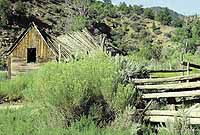| Late summer and early fall are excellent times to explore Nine Mile Canyon. Old farm and ranch sites are common along the way. |
Day trippng in Eastern Utah is an experience that no one can experience anywhere else on the planet. From mountain streams and lakes to the hottest red rock around, the sights, sounds and smells equal a good time.
In the north is the book cliffs and the many canyons that run through it like Willow Creek and Nine Mile. The north also holds two great museums in the likes of the College of Eastern Utah Prehistoric Museum in Price to the historic Mining and Railroad Museum in Helper.
Head farther south and the expansive San Rafael Swell takes over the scenery on the east along with the Wasatch Plateau on the west. Emery county’s high country has some great streams, lakes and reservoirs while the eastern part of the county boasts the Wedge, Black Box and about a zillion places where the geology is out of this world. Emery County’s museums include the Museum of the San Rafael in Castle Dale and the John Wesley Powell Museum in Green River. The Cleveland Lloyd Dinosaur Quarry is also an interesting site to see.
South of I-70 are places like Goblin Valley and Temple Mountain, where uranium miners plied their trade in the 1940’s, 50’s and 60’s. Along that interstate corridor is also Ghost Rocks and Eagle Canyon, a spectacular surprise to the first time traveler going across the area.
Nine Mile Canyon
Nine Mile Canyon is known as a major representative area of the prehistoric Fremont Culture and is a must when planning a day trip in Carbon County
Dry climate and isolation have allowed Nine Mile Canyon to remain virtually untouched for hundreds of years. Nine Mile is an outdoor museum with remarkable examples of Native American rock art and remnants of dwellings. The area contains the greatest concentration of rock art in the United States. The rugged, remote canyon begins 20 miles north of Wellington and stretches 40 miles along the northern side of the Book Cliffs. The Nine Mile rest area offers toilets, picnic tables, dispersed camping and group facilities.
The canyon houses myriad rock art panels along the main road and inside canyons. Petroglyphs, which are carvings on rock faces and pictographs, which are paintings on rock faces, depict animals, hunting scenes and iconic figures.
Careful observers may spot cliff granaries on high canyon ledges. In the 1800s the canyon was used by both fur trappers and the Army. Iron telegraph poles, stages stations and settler cabins are common sights.
Vegetation and terrain along this backroad area vary from high desert species to aspen groves. The buff colored cliffs of the canyons are highlighted by balanced rocks and window arches. Deer and elk are frequently seen.

